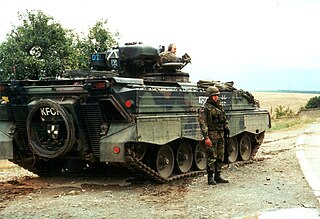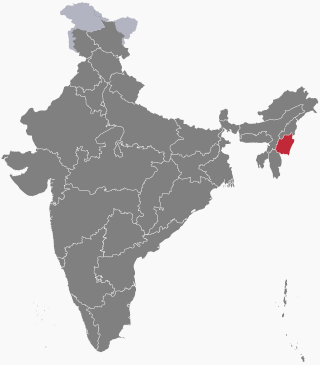Related Research Articles

The Hadassah convoy massacre took place on April 13, 1948, when a convoy, escorted by Haganah militia, bringing medical and military supplies and personnel to Hadassah Hospital on Mount Scopus, Jerusalem, was ambushed by Arab forces. Seventy-eight Jewish doctors, nurses, students, patients, faculty members and Haganah fighters, and one British soldier were killed in the attack, including twenty three women. Dozens of unidentified bodies, burned beyond recognition, were buried in a mass grave in the Sanhedria Cemetery.

The Qana massacre took place on April 18, 1996, near Qana, a village in then Israeli-occupied Southern Lebanon, when the Israeli military fired artillery shells at a United Nations compound, which was sheltering around 800 Lebanese civilians, killing 106 and injuring around 116. Four Fijian United Nations Interim Force in Lebanon soldiers were also seriously injured.

Kohima is the capital of the North East Indian state of Nagaland. With a resident population of almost 100,000, it is the second largest city in the state. Kohima constitutes both a district and a municipality. The municipality covers 20 km2 (7.7 sq mi). The city lies on the foothills of Japfü section of the Barail Range located south of the District and has an average elevation of 1,261 m (4,137 ft).

Terrorism in India, according to the Home Ministry, poses a significant threat to the people of India. Compared to other countries, India faces a wide range of terror groups. Terrorism found in India includes Islamist terrorism, ultranationalist terrorism, and left-wing terrorism. India is one of the countries most impacted by terrorism.

Mokokchung is a municipality in the Mokokchung District of the Indian state of Nagaland. It serves as the district headquarters as well as the main urban hub of Mokokchung District. Mokokchung is the cultural nerve centre of the Ao people and is economically and politically the most important urban centre in northern Nagaland. The town is made up of 16 wards of which Kumlong, Sangtemla, Alempang and Yimyu are the largest.

Joint Operation Nuevo León-Tamaulipas is an anti-drug joint operation in two Mexican states of Tamaulipas and Nuevo León by Federal Police and the Mexican Armed Forces. The objective of the joint operation is to eliminate Los Zetas and Gulf Cartel operations in the area. So far, many cartel members have been either killed or arrested. Recently Los Zetas and the Gulf Cartel have broken relations and started fighting each other.

During the 1989 Tiananmen Square protests and massacre in Beijing, the Chinese People's Liberation Army (PLA) played a decisive role in enforcing martial law, using force to suppress the demonstrations in the city. The killings of protestors in Beijing continue to taint the legacies of the party elders, led by Chinese leader Deng Xiaoping, and weigh on the generation of leaders whose careers advanced as their more moderate colleagues were purged or sidelined at the time. Within China, the role of the military in 1989 remains a subject of private discussion within the ranks of the party leadership and PLA.

The Battle of Newry Road was a running gun battle between British Army helicopters and Provisional Irish Republican Army (IRA) armed trucks, fought along the lanes east of Crossmaglen, County Armagh, on 23 September 1993. The engagement began when an IRA motorized team from the South Armagh Brigade attempted to ambush three helicopters lifting off from the British Army base at Crossmaglen, one of them carrying the 3rd Infantry Brigade Commander.
Timeline of the Boko Haram insurgency is the chronology of the Boko Haram insurgency, an ongoing armed conflict between Nigerian Islamist group Boko Haram and the Nigerian government. Boko Haram have carried out many attacks against the military, police and civilians since 2009, mostly in Nigeria. The low-intensity conflict is centred on Borno State. It peaked in the mid-2010s, when Boko Haram extended their insurgency into Cameroon, Chad and Niger.

The Prizren Incident was a confrontation between German Kosovo Force (KFOR) troops advancing into Kosovo and stragglers from the withdrawing Yugoslav Army. The shootout took place in the city of Prizren, on 13 June 1999. The German troops killed one armed Serb on the spot, while another one died of wounds later. A German soldier was injured by return fire, and there were reports of a woman wounded by Serb snipers.
The following lists events that happened during 2015 in Afghanistan.

The Insurgency in Manipur is an ongoing armed conflict between India and a number of separatist rebel groups, taking place in the state of Manipur. The Insurgency in Manipur is part of the wider Insurgency in Northeast India; it displays elements of a national liberation war as well as an ethnic conflict.

The SBA-60K2 Bulat armored personnel carrier (APC) was developed jointly by Kamaz and Zaschita corporation as a private venture. Development of this vehicle commenced in 2010 and was completed by 2013. It is a further 6x6 development of the earlier BPM-97 4x4 wheeled mine-resistant, ambush protected (MRAP) vehicle. Russia currently employs 15 Bulat vehicles received in late 2014, and ordered a new batch of further 50 vehicles from the Russian manufacturer Zashcita.
The Aluth Oya massacre was the massacre of 127 Sinhalese civilians, including children and women, by the cadres of Liberation Tigers of Tamil Eelam organization on April 17, 1987, near the village of Aluth Oya, on the Habarana Trincomalee road in North Central Province of Sri Lanka. This massacre is considered one of the most notorious and devastating atrocities committed by the LTTE during the history of the Sri Lankan Civil War.
Terrorist incidents in Pakistan in 2019 include:

The 2010 Mao Gate incident was a public-led demonstration held in Mao Gate, Manipur, India, on 6 May 2010. The protest was started after the Government of Manipur denied the entry of Thuingaleng Muivah into the state. The protest quickly escalated to police firing when the Government of Manipur declared martial law and sent its commando to occupy the town.

On 4 December 2021, a unit of 21st Para Special Forces of the Indian Army killed six civilians near the village of Oting in the Mon District of Nagaland, India. Eight more civilians and a soldier were killed in subsequent violence. The killings were widely condemned with many calling to repeal and revoke the Armed Forces Special Powers Act.

The 1994 Mokokchung Massacre also referred to as Ayatai Mokokchung by the citizens of the town, took place on 27 December 1994, when forces of the 10th Assam Rifles and the 12th Maratha Light Infantry of the Indian Army raided upon civilian populace of Nagaland's Mokokchung.
This is a timeline of the history of the Nagas.
The 2017 Nagaland protests were a series of protests and civil unrest in the northeastern Indian state of Nagaland that began on 27 January 2017 following the announcement of the 33% women reservation in the Civic Elections by the Government of Nagaland with violence beginning on the night of 31 January after the killings of two protestors by security forces. The civil unrest began in Dimapur, and later spread to various districts of Nagaland. The unrest grew rapidly after the killings, with people from different parts of Nagaland joining in the protests.
References
- ↑ Naleo, Villo (23 August 2016). "Nagaland: Remembering Truthfully and Forgiving Generously". Eastern Mirror . Retrieved 5 December 2021.
- "Nagaland Timeline - Year 1995". South Asia Terrorism Portal. Retrieved 5 December 2021. - ↑ Basu, Sayak (26 February 2023). "History of separatism in the conflicted northeastern state of Nagaland". Deccan Herald . Retrieved 22 March 2023.
- ↑ Bora, Aniruddha (6 July 2020). "AFSPA – The tale of Agony in Nagaland". Gauri Lankesh News . Retrieved 6 December 2021.